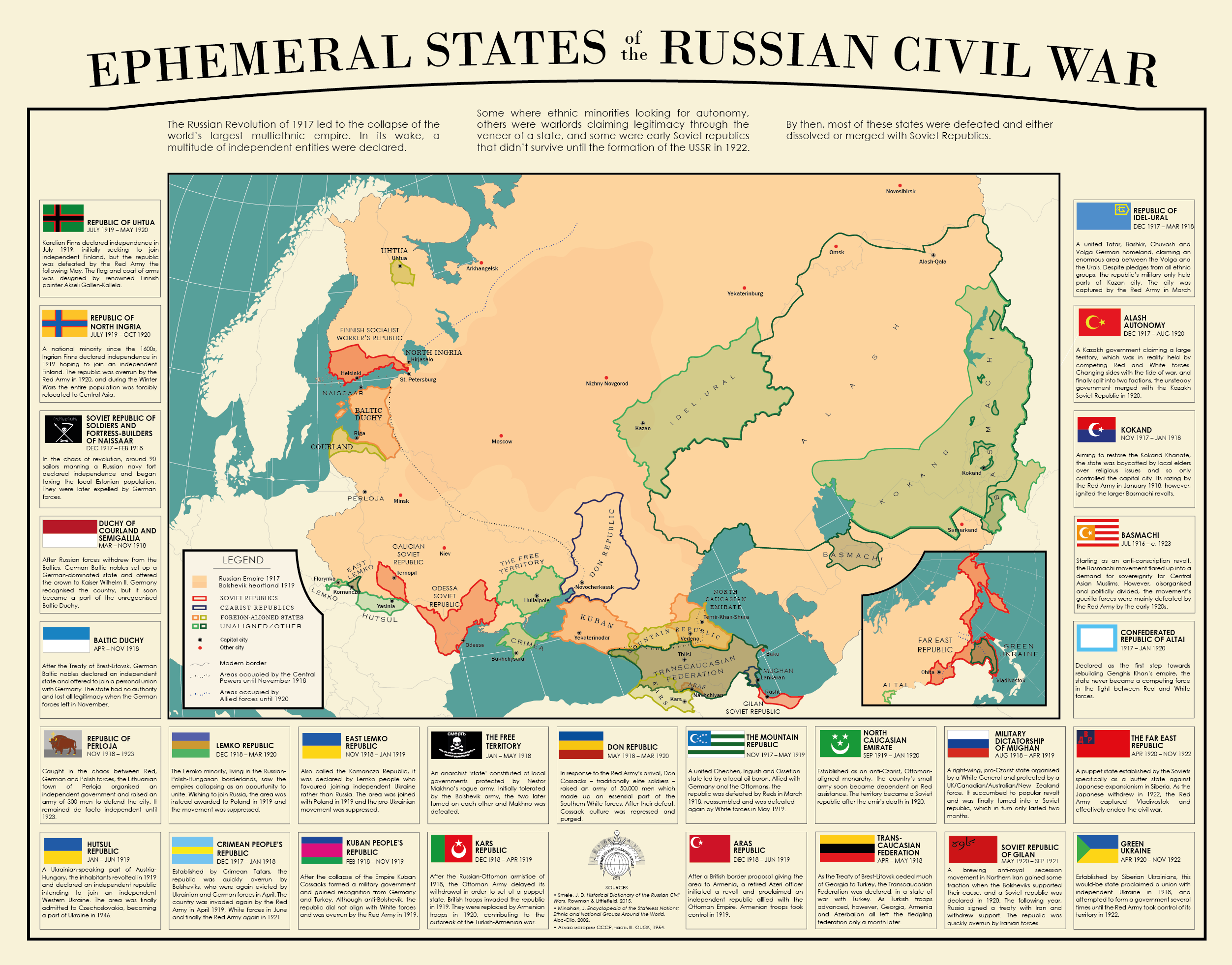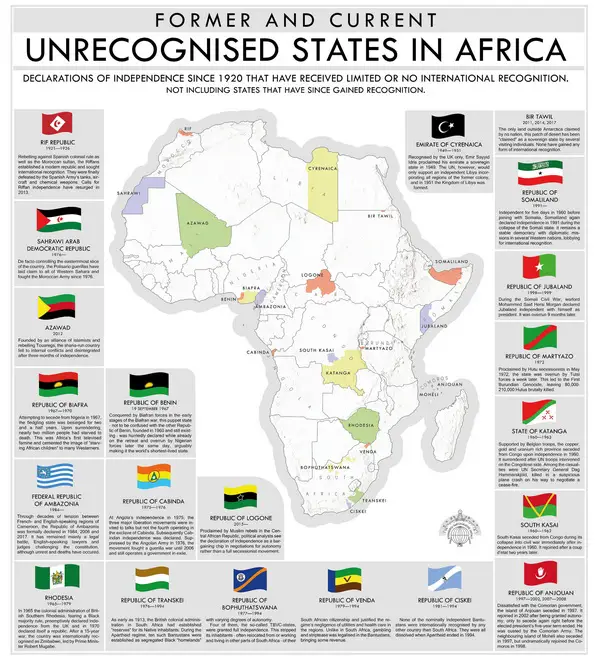Ephemeral states of the Russian civil war
The Russian Revolution of 1917 shattered the world’s largest multiethnic empire, triggering a chaotic struggle for power. In the aftermath, a mosaic of ephemeral states emerged—some driven by ethnic self-determination, others by revolutionary fervor or opportunistic warlords seeking legitimacy. Many of these entities were short-lived, crushed by the tides of the Russian Civil War, while a few were stepping stones toward modern nation-states.
The map below shows the ephemeral states of the Russian Civil War.

Table of Contents
Finnish and Baltic Aspirations
Republic of Uhtua (July 1919 – May 1920)
Karelian Finns declared independence, hoping to unite with Finland. Despite backing from Finnish volunteers, the Republic fell to the Red Army. Its symbols, including the flag and coat of arms, were designed by Finnish painter Akseli Gallen-Kallela.
Republic of North Ingria (July 1919 – Oct 1920)
The Ingrian Finns, a small ethnic group with deep historical ties to Finland, sought independence. Soviet Russia ultimately annexed their state, and during the Winter War, the entire Ingrian population was forcibly relocated to Central Asia.
Duchy of Courland and Semigallia (Mar – Nov 1918)
With the Russian retreat from the Baltics, Baltic German aristocrats established a German-aligned state. They offered the crown to Kaiser Wilhelm II, but the entity soon merged into the unrecognized Baltic Duchy.
Baltic Duchy (Apr – Nov 1918)
A short-lived state dominated by the Baltic German nobility, this entity aimed to join a personal union with Germany. However, with Germany’s withdrawal, it lost legitimacy and authority.
Microstates and Local Defenses
Republic of Perloja (Nov 1918 – 1923)
Caught in the crossfire between Red, German, and Polish forces, the Lithuanian town of Perloja declared self-rule. A local militia of 300 men maintained its autonomy until Lithuania regained control in 1923.
Soviet Republic of Soldiers and Fortress-Builders of Naissaar (Dec 1917 – Feb 1918)
On the Estonian island of Naissaar, Russian naval sailors declared independence and began taxing locals. Their rule ended swiftly when German forces expelled them.
Ukrainian and Cossack Efforts
Hutsul Republic (Jan – Jun 1919)
Formed by Ukrainian-speaking inhabitants of the former Austro-Hungarian Empire, this republic aimed to merge with an independent Ukraine. It was later incorporated into Czechoslovakia and eventually became part of Ukraine in 1946.
Lemko Republic (Dec 1918 – Mar 1920)
The Lemko people, living in the Carpathian region, sought union with Russia, but Poland annexed the area, suppressing the movement.
East Lemko Republic (Nov 1918 – Jan 1919)
A pro-Ukrainian Lemko state that lasted only months before Poland absorbed it.
Kuban People’s Republic (Feb 1918 – Nov 1919)
Kuban Cossacks established a semi-independent state, recognized by Germany and Turkey. Though anti-Bolshevik, they remained distant from White forces and ultimately fell to the Red Army.
The Free Territory (Jan – May 1918)
A self-governing anarchist enclave protected by Nestor Makhno’s militia. Initially tolerated by the Bolsheviks, they were later crushed as the Reds consolidated power.
Don Republic (May 1918 – Mar 1920)
Don Cossacks, historically elite soldiers of the Russian Empire, formed an independent military government. Their army of 50,000 men played a crucial role in White resistance, but after their defeat, Soviet authorities repressed Cossack culture.
Southern and Caucasian Struggles
Kars Republic (Dec 1918 – Apr 1919)
A puppet state established by the Ottoman Army during their withdrawal from Russian-controlled territory. It was soon overrun by British and later Armenian forces, leading to further conflict.
Mountain Republic (Nov 1917 – May 1919)
A multiethnic state of Chechens, Ingush, and Ossetians, led by an oil baron. Allied with Germany and the Ottomans, it was twice defeated—first by the Bolsheviks, then by White forces.
North Caucasian Emirate (Sep 1919 – Jan 1920)
An anti-Czarist monarchy aligned with the Ottomans, but reliant on Bolshevik support. Following the emir’s death, it was absorbed into Soviet rule.
Aras Republic (Dec 1918 – Jun 1919)
A revolt against a British border proposal led an Azeri officer to declare independence. The republic was ultimately annexed by Armenia in 1919.
Transcaucasian Federation (Apr – May 1918)
A fragile union of Georgia, Armenia, and Azerbaijan, was created to resist Turkish expansion. Internal divisions led to its dissolution within a month.
Central Asian Resistance
Military Dictatorship of Mughan (Aug 1918 – Apr 1919)
A pro-Czarist state under a White Russian general, protected by UK, Australian, and New Zealand forces. Popular revolt led to its downfall, and it briefly became a Soviet republic before vanishing.
Soviet Republic of Gilan (May 1920 – Sep 1921)
An Iranian secessionist movement supported by Soviet Russia. However, when the Soviets signed a treaty with Iran, they withdrew support, leading to its swift collapse.
Republic of Idel-Ural (Dec 1917 – Mar 1918)
A multiethnic republic encompassing Tatars, Bashkirs, Chuvash, and Volga Germans. Its military controlled only parts of Kazan before being overwhelmed by the Red Army.
Alash Autonomy (Dec 1917 – Aug 1920)
A Kazakh nationalist government that lacked control over its vast claimed territory. Its leadership eventually split, and the republic merged into Soviet Kazakhstan.
Kokand Autonomy (Nov 1917 – Jan 1918)
An attempt to restore the Kokand Khanate. However, divisions among local elites left it weak, and the Red Army’s destruction of the city sparked broader resistance in Central Asia.
Basmachi Revolt (Jul 1916 – c. 1923)
A guerrilla movement rather than a formal state, the Basmachis fought against Soviet rule in Central Asia for nearly a decade, blending nationalism with Islamic resistance.
Final Thoughts
The Russian Civil War gave rise to an astonishing variety of ephemeral states, many of which flickered out in mere months. Whether motivated by nationalism, political ideology, or survival, these fledgling republics illustrate the chaos that followed the fall of the Russian Empire. While most were quickly absorbed into the expanding Soviet sphere, their stories offer a fascinating glimpse into the fractured and contested landscape of the early 20th century.
Related post:
– The Ephemeral States of the Napoleonic Period








